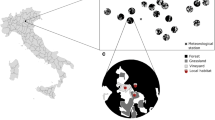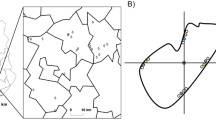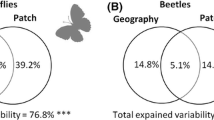Abstract
Context
Insect species of different trophic level will respond differently to landscape configuration.
Objective
In this context we explore the way landscape structure affects the distribution and abundance of the whitefly Siphoninus phillyreae and its predator Clitostethus arcuatus in olive orchards.
Methods
Adult individuals of these two species were collected using sticky traps placed in 12 olive host patches in Argentina. Host patches were detected and quantified using Landsat 5 TM images. Different landscape metrics were estimated for the study area land covers. PLSR analysis techniques were employed to relate the mean abundance of the studied species and the landscape measures.
Results
The Landsat land use estimations showed that most of the vegetation is limited to particular irrigated spots or urban areas. 89 % of the land cover is exposed soil, 10 % is xerophytic vegetation, 0.56 % is introduced urban vegetation and 0.31 % is occupied by olive orchards. S. phillyreae was positively affected by total area of olive orchards, followed by total area of urban vegetation, and negatively affected by the perimeter of olive focal patch and the proximity of other urban vegetation patches. C. arcuatus was positively affected by the perimeter of the host patch, the total area of olive orchards and the mean proximity of urban vegetation patches.
Conclusion
We concluded that although the total area of the herbivore host was the most influential variable affecting the two species, each of them was affected in different way by other landscape elements.






Similar content being viewed by others
References
Abd-Rabou S (2006) Biological control of the pomegranate whitefly, Siphoninus phillyreae (Homoptera: Aleyrodidae: Aleyrodinae) by using the bioagent, Clitostethus arcuatus (Coleoptera: Coccinellidae). J Entomol 3(4):331–335
Agekian NG (1977) Clitostethus arcuatus Rossi (Coleoptera, Coccinellidae)—predator of citrus whitefly in Adzharia. Entomologicheskoye Obozrenie 56:31–33
Andren H (1994) Effects of habitat fragmentation on birds and mammals in landscapes with different proportions of suitable habitat: a review. Oikos 71:355–366
Bach CE (1988a) Effect of host plant patch size on herbivore density: patterns. Ecology 6:1090–1102
Bach CE (1988b) Effect of host plant patch size on herbivore density: underlying mechanisms. Ecology 69:1103–1117
Bascompte J, Sole RV (1998) Effects of habitat destruction in a prey predator metapopulation model. J Theor Biol 195:383–393
Bathon VH, Pietrzik J (1986) On the food consumption of Clitostethus arcuatus (Rossi) (Col.: Coccinellidae), a predator of Aleurodes proletella L. (Hom.: Aleyrodidae). J Appl Entomol 102:321–326
Bellows TS, Paine TB, Arakawa KY, Meisenbacher C, Leddy P, Kabashim J (1990) Biological control sought for ash whitefly. Calif Agric (Berkeley) 44:4–6
Bellows TS, Paine TD, Gerling D (1992) Development, survival, longevity, and fecundity of Clitostethus arcuatus (Coleoptera: Coccinellidae) on Siphoninus phillyreae (Homoptera: Aleyrodidae) in the laboratory. Environ Entomol 21(3):659–663
Bender DJ, Contreras TA, Fahrig L (1998) Habitat loss and population decline: a meta-analysis of the patch size effect. Ecology 79:517–533
Biurrun F, Agüero N, Walter D, Teruel, DF (2012) Consideraciones fitogeográficas sobre la vegetación de los llanos de La Rioja. Instituto Nacional de Tecnología Agropecuaria, Buenos Aires, Argentina
Boivin G, Roger C, Coderre D, Wajnberg E (2010) Learning affects prey selection in larvae of a generalist coccinellid predator. Entomol Exp Appl 135:48–55
Bommarco R, Banks JE (2003) Scale as modifier in vegetation diversity experiments: effects on herbivores and predators. Oikos 102:440–448
Bowers MA, Matter SF (1997) Landscape ecology of mammals: relationships between density and patch-size. J Mammal 78:999–1013
Bukovinszky T, Potting RPJ, Clough Y, van Lenteren JC, Vet LEM (2005) The role of pre- and post-alighting detection mechanisms in the responses to patch size by specialist herbivores. Oikos 109:435–446
Byrne D (1999) Migration and dispersal by the sweet potato whitefly, Bemisia tabaci. Agric For Meteorol 97:309–316
Cantrell RS, Cosner C, Fagan WF (2001) How predator incursions affect critical patch size: the role of the functional response. Am Nat 158:368–375
Cantrell RS, Cosner C, Fagan WF (2002) Habitat edges and predator—prey interactions: effects on critical patch size. Math Biosci 175:31–55
Capman WC, Batzli GO, Simms LE (1990) Responses of the common sooty wing skipper to patches of host plants. Ecology 71:1430–1440
Chalfoun AD, Thompson FR, Ratnaswamy MJ (2002) Nest predators and fragmentation: a review and metaanalysis. Conserv Biol 16:306–318
Cheng Q, Sun DW (2005) Application of PLSR in correlating physical and chemical properties of pork ham with different cooling methods. Meat Sci 70:691–698
Cohen S (1990) Epidemiology of whitefly-transmitted viruses. In: Gerling D (ed) Whiteflies: their bionomics, pest status and management. Intercept, Andover, UK, pp 210–225
Congalton RG, Green K (1999) Assessing the accuracy of classifications of remotely sensed data: principles and practices. Lewis Publishers (CRC Press Inc.), New York, p 209
Connor EF, Coutney AC, Yoder JM (2000) Individuals–area relationship: the relationship between animal population density and area. Ecology 81:734–748
Crist TO, Guertin DS, Wiens JA, Milne BT (1992) Animal movement in heterogeneous landscapes: an experiment with Eleodes beetles in shortgrass prairie. Funct Ecol 6:536–544
Cronin JT (2003) Movement and spatial population structure of a prairie planthopper. Ecology 84:1179–1188
Cronin JT, Haynes KJ (2004) An invasive plant promotes unstable host–parasitoid patch dynamics. Ecology 85:2772–2782
Eastman RJ (2006) IDRISI Andes guide to GIS and image processing. Clark Labs, Clark University, Worcester, MA, p 328
Elliott NC, Kieckhefe RW, Michels GJ, Giles KL (2002) Predator abundance in alfalfa fields in relation to aphids, within-field vegetation, and landscape matrix. Environ Entomol 31:253–260
Elzinga JA, van Nouhuys S, van Leeuwena DJ, Biere A (2007) Distribution and colonisation ability of three parasitoids and their herbivorous host in a fragmented landscape. Basic Appl Ecol 8:75–88
Fahrig L, Jonsen I (1998) Effect of habitat patch characteristics on abundance and diversity of insects in an agricultural landscape. Ecosystems 1:197–205
Forman RTT, Godron M (1986) Landscape ecology. Wiley, New York
Gasparini ML, Holgado MG, Rodriguez F (2007) Presencia de Clitostethus arcuatus (Coleoptera: Coccinellidae) sobre olivos infestados con Siphoninus phillyreae (Hemiptera: Aleyrodidae) en Argentina. Revista de la Sociedad Entomológica Argentina 66:169–170
Gerling D (1990) Natural enemies of white flies: predators and parasitoids. In: Gerling D (ed) White flies: their bionomics, pest status and management. Intercept, Andover, Hants, UK, pp 147–185
Gerling D, Alomar O, Arno J (2001) Biological control of Bemisia tabaci using predators and parasitoids. Crop Prot 20:779–799
Gerling D, Rottenberg O, Bellows TSJ (2004) Role of natural enemies and other factors in the dynamics of field populations of the whitefly Siphoninus phillyreae (Haliday) in introduced and native environments. Biol Control 31:199–209
González G (1996) Los Coccinellidae de Chile. http://www.coccinellidae.cl. Accessed 18 March 2015
González A, Lawton JH, Gilbert FSM, Blackburn T, Evans-Freke I (1998) Metapopulation dynamics, abundance, and distribution in a microecosystem. Science 281:2045–2047
Grez AA, Zaviezo T, Rios M (2005) Ladybird (Coleoptera: Coccinellidae) dispersal in experimental fragmented alfalfa landscapes. Eur J Entomol 102:209–216
Grilli MP (2010) The role of landscape structure on the abundance of a disease vector planthopper: a quantitative approach. Landscape Ecol 25:383–394
Grilli MP, Bruno MA (2007) Regional abundance of a planthopper pest: the effect of host patch area and configuration. Entomol Exp Appl 122:133–143
Gustafson EJ (1998) Quantifying landscape spatial pattern: what is the state of the art? Ecosystems 1:143–156
Gustafson E, Parker GR (1992) Relationships between land cover proportion and indices of landscape spatial pattern. Landscape Ecol 7:101–110
Hamback PA, Englund G (2005) Patch area, population density and the scaling of migration rates: the resource concentration hypothesis revisited. Ecol Lett 8:1057–1065
Hanski I (1994) A practical model of metapopulation dynamics. J Anim Ecol 63:151–162
Hanski I (1999) Metapopulation Ecology. Oxford University Press, New York
Hanski I, Gilpin ME (1997) Metapopulation biology: ecology, genetics, and evolution. Academic, San Diego, CA
Hodek I, Evans EW (2012) Food relationships. In: Hodek I, van Emden HF and Honek A (eds) Ecology and behaviour of the ladybird beetles (Coccinellidae). Wiley-Blackwell, UK, pp 141–274
Hodek I, Honek A (2009) Scale insects, mealybugs, whiteflies and psyllids (Hemiptera, Sternorrhyncha) as prey of ladybirds. Biol Control 51:232–243
Holgado M, Saez C, Llera J, Gasparini M, Anzorena G, Bataglia M, Cid P, Pasquale N (2005) Fluctuación poblacional de Siphoninus phillyreae (Hemiptera-Aleyrodidae) en olivos de Mendoza. Libro de Resúmenes VI Congreso Argentino de Entomología, San Miguel de Tucumán, Argentina
Holt RD (2002) Food webs in space: on the interplay of dynamic instability and spatial processes. Ecol Res 17:261–273
Holt RD, Lawton JH, Polis GA, Martinez ND (1999) Trophic rank and the species–area relationship. Ecology 80:1495–1504
Honek A (2012) Distribution and habitats. In: Hodek I, van Emden HF and Honek A (eds) Ecology and behaviour of the ladybird beetles (Coccinellidae). Wiley-Blackwel, UK, pp 110–140
Inc StatSoft (2001) STATISTICA for Windows (computer program manual). StatSoft Inc., Tulsa, Oklahoma (StatSoft Inc., 2300 East 14th Street, Tulsa, Oklahoma)
Indec (2002) Censo Nacional Agropecuario 2002. http://www.indec.mecon.gov.ar/agropecuario/cna_principal.asp. Accessed 18 March 2015
Jonsen ID, Fahrig L (1997) Response of generalist and specialist insect herbivores to landscape spatial structure. Landscape Ecol 12:185–197
Katsoyannos P, Ifantis K, Kontodimas DC (1997) Phenology, population trend and natural enemies of Aleurothrixus floccosus (Hom.: Aleyrodidae) at a newly invaded area in Athens, Greece. Entomophaga 42:619–628
Kondoh M (2003) Habitat fragmentation resulting in overgrazing by herbivores. J Theor Biol 225:453–460
Lahti DC (2001) The “edge effect on nest predation” hypothesis after twenty years. Biol Conserv 99:365–374
Landgrebe DA (2003) Signal theory methods in multispectral remote sensing. Wiley Interscience, New York
Laurance WF, Yensen E (1991) Predicting the impacts of edge effects in fragmented habitats. Biol Conserv 55:77–92
Liotta G (1981a) La mosca bianca fioccosa degli agrumi. Informatore Fitopatologico 32:11–15
Liotta G (1981b) Osservazioni bio-ecologiche su Clitostethus arcuatus (Rossi) (Col. Coccinellidae) in Sicilia. Redia 64:173–185
MacArthur RH, Levins R (1964) Competition, habitat selection, and character displacement in a patchy environment. Proc Natl Acad Sci USA 51:1207–1210
Martens H, Naes T (1989) Multivariate calibration. Wiley, New York
McGarigal K, Marks BJ (1995) FRAGSTATS: spatial pattern analysis program for quantifying landscape structure. General Technical Report PNW-GTR-351. USDA Forest Service, Pacific Northwest Research Station, Portland, Oregon
McGarigal K, Cushman SA, Ene E (2012) FRAGSTATS v4: spatial pattern analysis program for categorical and continuous maps. Computer software program produced by the authors at the University of Massachusetts, Amherst. http://www.umass.edu/landeco/research/fragstats/fragstats.html. Accessed 18 March 2015
Melian CJ, Bascompte J (2002) Food web structure and habitat loss. Ecol Lett 5:37–46
Mills NJ (1981) Essential and alternative foods for British Coccinellidae (Coleoptera). Entomol Gaz 32:197–202
Milne BT, Turner MG, Wiens JA, Johnson AR (1992) Interactions between the fractal geometry of landscapes and allometric herbivory. Theor Popul Biol 41:337–353
Morrison JA (1996) Infection of Juncus dichotomus by the smut fungus Cintractia junci: an experimental field test of the effects of neighbouring plants, environment, and host plant genotype. J Ecol 84:691–702
Murphy HT, Lovett-Doust J (2004) Context and connectivity in plant metapopulations and landscape mosaics: does the matrix matter? Oikos 105:3–14
Nakagiri N, Tainaka K (2004) Indirect effects of habitat destruction in model ecosystems. Ecol Model 17:103–114
Nakagiri N, Tainaka KI, Tao T (2001) Indirect relation between species extinction and habitat destruction. Ecol Model 137:109–118
Ostergard H, Ehrlen J (2005) Among population variation in specialist and generalist seed predation, the importance of host plant distribution, alternative hosts and environmental variation. Oikos 111:39–46
Paton PWC (1994) The effect of edge on avian nest success—how strong is the evidence. Conserv Biol 8:17–26
Peña MA (1994) Siphoninus phillyrae (Haliday, 1835), una nueva mosca blanca para la fauna canaria (Homoptera, Aleyrodidae). Boletín de sanidad vegetal—Plagas 20(3):601–604
Prakash S, De Roos AM (2002) Habitat destruction in a simple predator–prey patch model: how predators enhance prey persistence and abundance. Theor Popul Biol 62:231–249
Priore R (1969) Dealeurodes citri (Ashmead) (Homoptera: Aleyrodidae) in Campania. Bollettino del Laboratorio di Entomologia Agraria Filippo Silvestri 27:287–316
Rand TA, Louda SM (2006) Spillover of agriculturally subsidized predators as a potential threat to native insect herbivores in fragmented landscapes. Conserv Biol 20:1720–1729
Rand TA, Tscharntke T (2007) Contrasting effects of natural habitat loss on generalist and specialist aphid natural enemies. Oikos 116:1353–1362
Rand TA, Tylianakis JM, Tscharntke T (2006) Spillover edge effects: the dispersal of agriculturally subsidized insect natural enemies into adjacent natural habitats. Ecol Lett 9:603–614
Revilla E, Wiegand T, Palomares F, Ferreras P, Delibes M (2004) Effects of matrix heterogeneity on animal dispersal: from individual behavior to metapopulation level parameters. Am Nat 164:130–153. doi:10.1086/424767
Ricketts TH (2001) The matrix matters: effective isolation in fragmented landscapes. Am Nat 158:87–99. doi:10.1086/320863
Ries L, Fletcher RJ, Battin J, Sisk TD (2004) Ecological responses to habitat edges: mechanisms, models, and variability explained. Annu Rev Ecol Evol 35:491–522
Root RB (1973) Organization of a plant-arthropod association in simple and diverse habitats: the fauna of collards (Brassica oleracea). Ecol Monogr 43:95–124
Ryal LK, Fahrig L (2006) Response of predators to loss and fragmentation of prey habitat: a review of theory. Ecology 87(5):1086–1093
Sabins F (1997) Remote sensing principles and interpretation. W. H. Freeman and Company, New York
Searles PS, Agüero Alcarás M, Rousseaux MC (2011) El consumo del agua por el cultivo de olivo (Olea europaea L.) en el noroeste de Argentina: una comparación con la Cuenca Mediterránea. Ecología Austral 21:15–28
Sheehan W (1986) Response by Specialist and Generalist Natural Enemies to Agroecosystem Diversification: a Selective Review. Environ Entomol 15(3):456–461
Steffan-Dewenter I, Tscharntke T (2000) Butterfly community structure in fragmented habitats. Ecol Lett 3:449–456
Swihart RK, Feng Z, Slade NA, Mason DM, Gehring TM (2001) Effects of habitat destruction and resource supplementation in a predator–prey metapopulation model. J Theor Biol 210:287–303
Tenenhaus M (1998) La Regression PLS: theorie et pratique. Technip, Paris
Thies C, Steffan-Dewenter I, Tscharntke T (2003) Effects of landscape context on herbivory and parasitism at different spatial scales. Oikos 101:18–25
Tscharntke T (2000) Parasitoid populations in agricultural landscapes. In: Hochberg ME, Ives AR (eds) Parasitoid population biolog y. Princeton University Press, Princeton, NJ, pp 235–253
Tscharntke T, Brandl R (2004) Plant–insect interactions in fragmented landscapes. Annu Rev Entomol 49:405–430. doi:10.1146/annurev.ento.49.061802.123339
Tscharntke T, Kruess A (1999) Habitat fragmentation and biological control. In: Hawkins BA, Cornell HV (eds) Theoretical approaches to biological control. Cambridge University Press, Cambridge, UK, pp 190–205
van Nouhuys S (2005) Effects of habitat fragmentation at different trophic levels in insect communities. Ann Zool Fennici 42:433–447
van Nouhuys S, Hanski I (2002) Colonization rates and distances of a host butterfly and two specific parasitoids in a fragmented landscape. J Anim Ecol 71:639–650. doi:10.1046/j.1365-2656.2002.00627.x
van Nouhuys S, Hanski I (2005) Metacommunities of butterflies, their host plants and their parasitoids. In: Holyoak M, Leibold MA, Holt RD (eds) Metacommunities: spatial dynamics and ecological communities. University of Chicago Press, Chicago, pp 99–121
van-Lenteren JC, Noldus LP (1990) Whitefly–plant relationships: behavioural and ecological aspects. In: Gerling D (ed) Whiteflies: their bionomics, pest status and management. Intercept, Andover, UK, pp 47–89
Venzon M, Janssen A, Sabelis MW (2002) Prey preference and reproductive success of the generalist predator Orius laevigatus. Oikos 97:116–124
Viscarret MM, Botto EN (1996) Descripción e identificación de Trialeuroides vaporariorum (westwood) y Bemisia tabaci (Gennadius), (Hemiptera, Homoptera: Aleyroididae). Revista chilena de Entomología 23:51–58
Viscarret MM, Botto EN (1997) Presencia de Siphoninus phillyreae (Haliday), “la mosca blanca de los fresnos” (Homptera: Aleyrodidae), en la Argentina. Revista de la Sociedad Entomológica Argentina 56(1–4):90
Wiens JA (1989) Spatial scaling in ecology. Funct Ecol 3:385–397
Wiens JA (1997) Metapopulation dynamics and landscape ecology. In: Hanski IA, Gilpin ME (eds) Metapopulation biology: ecology, genetics, and evolution. Academic, San Diego, California, USA, pp 43–67
Wilcove DS, McLellan C, Dobson A (1986) Habitat fragmentation in the temperate zone. In: Soule ME (ed) Conservation biology: the science of scarcity and diversity. Sinauer Associates, Sunderland, MA, pp 237–256
With KA (2004) Metapopulation dynamics: perspectives from landscape ecology. In: Hanski I, Gaggiotti OE (eds) Ecology, genetics, and evolution of metapopulations. Elsevier Academic, Boston, MA, pp 23–44
With KA, Pavuk DM, Worchuck J, Oates RK, Fisher JL (2002) Treshold effects of landscape structure on biological control in agroecosystems. Ecol Appl 12:52–65
Wold S, Albano C, Dunn WJ, Edlund U, Eliasson B, Johansson E, Norden B, Sjöström M (1982) The indirect observation of molecular chemical systems. In: Jöreskog KG, Wold H (eds) Systems under indirect observation, vol I and II. North-Holland, Amsterdam, pp 177–207
Wold S, Sjöström M, Eriksson L (2001) PLS-regression: a basic tool of chemometrics. Chemometr Intell Lab Syst 58:109–130
Author information
Authors and Affiliations
Corresponding author
Rights and permissions
About this article
Cite this article
Grilli, M.P., Pedemonte, M.L., Bruno, M. et al. The effect of landscape structure on two species of different trophic levels in an arid environment. Landscape Ecol 30, 1335–1349 (2015). https://doi.org/10.1007/s10980-015-0190-8
Received:
Accepted:
Published:
Issue Date:
DOI: https://doi.org/10.1007/s10980-015-0190-8




